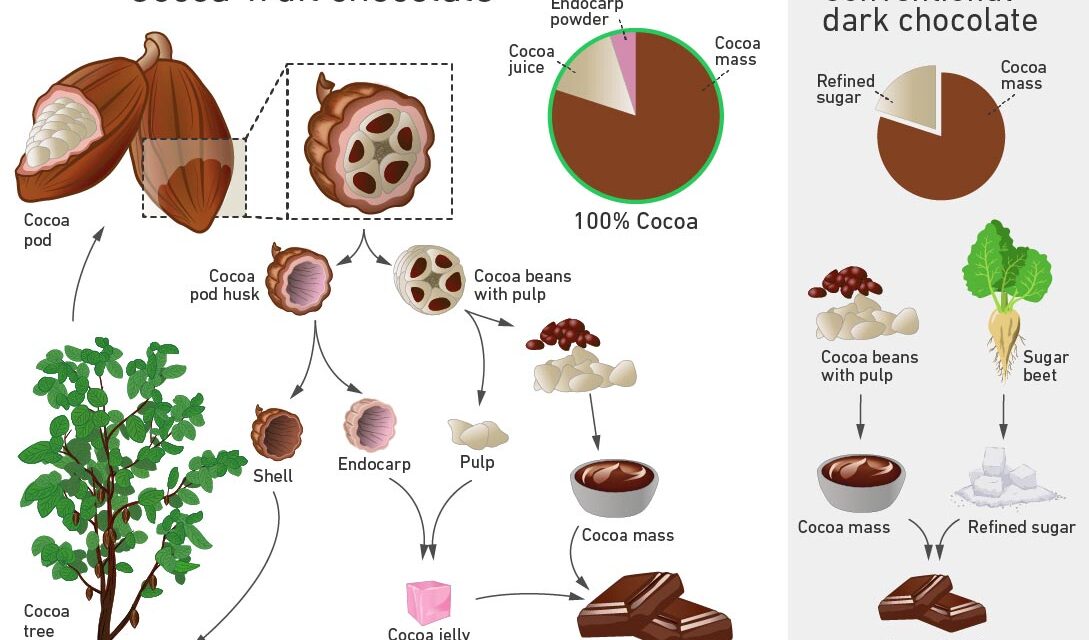ETH researchers have developed a type of chocolate that is more sustainable and nutritious than conventional varieties. This new chocolate, known as cocoa-fruit chocolate, uses cocoa fruit jelly as a replacement for powdered sugar, reducing the sugar content and increasing the product’s nutritional value. Additionally, it offers small farmers the opportunity to diversify their income sources.
Traditional chocolate relies on cocoa mass and cocoa butter, derived from the cocoa fruit, but many other valuable components of the fruit are underutilized. In a new Innosuisse project, researchers from ETH Zurich, sustainability-focused chocolate start-up Koa, and Swiss chocolate manufacturer Felchlin are collaborating to create a new chocolate recipe that maximizes the use of the whole cocoa plant, resulting in a healthier, more sustainable product that enhances the profitability of cocoa cultivation.
Crafting the Perfect Chocolate Recipe
The cocoa fruit resembles the honeydew melon in structure. According to Kim Mishra, lead author of the team’s Nature Food publication, both fruits have a hard outer shell that encases the flesh, seeds, and pulp. While traditional chocolate production uses only the beans, the new cocoa-fruit chocolate recipe incorporates the fruit’s flesh and parts of its shell into a powder mixed with pulp to create a cocoa gel. This naturally sweet gel effectively substitutes for powdered sugar.
Perfecting the recipe involved balancing the texture and sweetness of the chocolate. Researchers found that up to 20 percent of cocoa gel could be used without compromising texture, providing sweetness equivalent to 5 to 10 percent powdered sugar. Conventional dark chocolate typically contains 30 to 40 percent powdered sugar.
Sensory Testing and Health Benefits
Trained panelists from the Bern University of Applied Sciences conducted sensory tests on the new chocolate recipes, comparing pieces sweetened with cocoa gel to those with varying amounts of powdered sugar. Chocolate made with cocoa gel has more fiber and less fat than standard dark chocolate. It contains 15 grams of fiber per 100 grams compared to 12 grams in regular chocolate and has 23 grams of saturated fat versus 33 grams in standard dark chocolate.
“Fiber is valuable from a physiological perspective because it regulates intestinal activity and prevents rapid spikes in blood sugar levels,” explains Mishra. “Excessive saturated fat consumption is linked to an increased risk of cardiovascular diseases.”
Economic and Sustainable Impacts
Using the entire cocoa fruit for chocolate production allows small-scale farmers to diversify their product offerings and increase their income. Farmers can sell not only the beans but also the dried juice from the pulp and endocarp, creating three revenue streams. This comprehensive utilization makes cocoa cultivation more sustainable.
Future Directions
Cocoa-fruit chocolate won’t be available in stores soon. “Although our chocolate is attractive and offers a comparable sensory experience to normal chocolate, the entire value creation chain needs adaptation,” says Mishra. “Cocoa farmers will need drying facilities, and large-scale production requires sufficient powder produced by food processing companies.” ETH has filed a patent for the cocoa-fruit chocolate recipe, marking a promising start toward improving the value-creation chain of the cocoa plant through technology, nutrition, eco-compatibility, and income diversification for small farmers.
Reference: “Valorization of cocoa pod side streams improves nutritional and sustainability aspects of chocolate” by Kim Mishra, Ashley Green, Johannes Burkard, Irina Gubler, Roberta Borradori, Lucas Kohler, Johannes Meuli, Ursina Krähenmann, Jotam Bergfreund, Armin Siegrist, Maria Schnyder, Alexander Mathys, Peter Fischer, and Erich J. Windhab, published on May 21, 2024, in Nature Food. DOI: 10.1038/s43016-024-00967-2.











